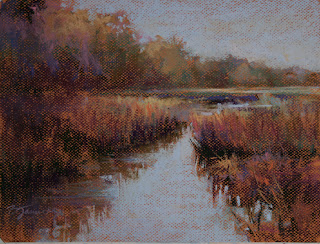 |
| Minimal stroke pastel exercise: created with no more than 100 strokes. 5 x 7 |
 |
| The Road Not Taken, pastel, 5 x 7 Started with the same approach as the minimal stroke exercise. |
Most pastel artists are attracted to the beautiful edges that we're able to create with pastel, which are unique to the medium. With no other medium can you create quite the same effect. Yet, so many of us tend to overwork our pastel paintings with far too many strokes of pastel pigment than is really needed. It's that yearning for perfection at every step of the painting that causes us to redo every stroke numerous times. I've learned that, especially in the early stages of a painting, we're better off putting down the stroke and leaving it alone! When you give yourself only a certain number of strokes to use, you need to ration them, and you're less likely to "fuss." You're also more thoughtful about not only the color and value of the stroke, but also how you'll hold the pastel stick, what direction to move it, and how much of it should touch the surface in order to create the stroke you want for that particular spot.
If you want to give this a try, you'll want to work small, about 5 x 7, or else you'll need many more strokes to cover the surface than the 100 I suggest for an exercise like the one shown above.
See my previous blog post on minimal stroke exercises for more details about what I cover in this class.







